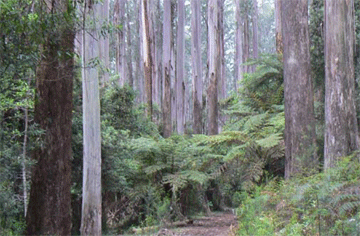Australia’s forests contain three times the expected carbon
Australia’s forests contain three times the expected carbon
mongabay.com
August 6, 2008
|
|
Australia’s natural eucalypt forests store three times the carbon conventionally believed, reports a new study by scientists at the Australian National University.
The researchers found that wet eucalypt forests of Victoria and Tasmania can contain more than 1200 tons of carbon per hectare, and up to a maximum of 2000 tons per hectare, including both aboveground biomass and soil carbon. They calculated that the average amount of carbon stored in unlogged natural eucalypt forests is about 640 tonnes per hectare, or three times the Intergovernmental Panel on Climate Change (IPCC) estimate of 217 tons of carbon per hectare. The work suggests that the 14.5 million hectares of eucalypt forest in southeastern Australian may store up to 9.3 billion tons of carbon, rather than the 3.1 billion tons estimated by the IPCC.
The scientists say their estimates differ from those by the IPCC due to differences in carbon storage between logged and unlogged forests. Unlogged forests store far greater amounts of carbon than logged forests.
 Mountain ash (Eucalyptus regnans) forest in Dandenong Ranges National Park, Victoria (900 t of C/ha of biomass carbon). Photo: Sandra Berry. |
“The remaining intact natural forests constitute a significant standing stock of carbon that should be protected from carbon emitting land-use activities,” the authors write. “There is substantial potential for carbon sequestration in forest areas that have been logged if they are allowed to re-grow undisturbed by further intensive human land-use activities.”
The scientists estimate that allowing logged forests to recover will sequester some 136 million tons of carbon dioxide annually over the next 100 years, an amount equal to 24 percent of the country’s 2005 net greenhouse gas emissions across all sectors.
Green Carbon